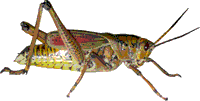Entomology Collections, General

Entomology Papers from Other Sources
Document Type
Article
Date of this Version
1998
Abstract
The weevil Bangastemus orientalis Capiomont was selected as a candidate for the biological control of Centaurea solstitialis L. (yellow starthistle) in the United States. Its potential host range was studied during 1982, 1983, and 1984 in Rome, Italy, using populations collected from C. solstitialis in Thermi near Thessaloniki and Kozani in northern Greece. Adults laid eggs only on members of the genus Centaurea and the thistle Onopordum acanthium; eggs laid on O. acanthium hatched but 1st instars died before entering buds. There was no significant difference in the number of eggs laid on various U.S. and Italian strains of C. solstitialis included in the tests. Eggs were not deposited on plant species of economic importance such as Cynara scolymus, Helianthus annus, Carthamus tinctorius, andLactuca sativa. Larvae completed their larval development only on C. solstitialis from Greece and on U. S. and Italian populations of C. solstitialis among the 60 plant species, varieties, and strains (in 7 families) tested. This restricted host range suggested introduction of this weevil as a biological control agent against yellow starthistle in the United States. Releases of B. orientalis were made in California, Washington, Idaho, and Oregon in 198.5 and it became established in all states in 1989.


Comments
Published in Environ. Entomol. 27(6): 1525-1530 (1998).